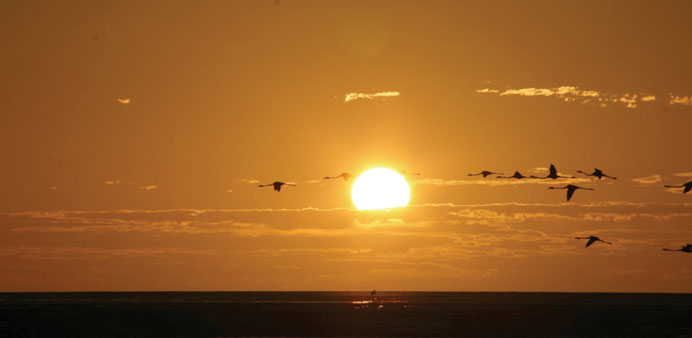By Menna Mohamed Saleh and Jutta Leyrer
In 1976, the Mauritanian government recognised the Banc d’Arguin as a national park. On the West coast of Africa - the Banc d’Arguin is one of the largest national parks on the African continent. Its covers both marine intertidal soft-sediment habitats as well as the arid desert environments of the Sahara. Its immense primary production is the essential base of a food web that drives large parts of the extremely rich fishing grounds just off the West African coast.
The Banc d’Arguin national park (PNBA) also provides nursery grounds for a number of off-shore fish species, and it is a hugely important refuge for sharks and rays as well as marine turtles. The satellite reserve Cap Blanc just north of PNBA was added in 1986, its breeding colony of the endangered monk seals harbours 50% of the total global population. Furthermore, around 2mn migratory birds – many of them breed as far north as the High Arctic tundra - find safe wintering grounds at PNBA. This makes PNBA one of the largest and most important non-breeding sites for migratory shore- and waterbirds within the East Atlantic Flyway, which stretches along the West European and West African coast from as north as Greenland and Siberia down to South Africa. Consequently, PNBA has been announced a RAMSAR wetland in 1982.
With an area of 12,000km2, the PNBA covers 180km of the coast, which is approx. 1/3 of the entire Mauritanian coastline. The particularly visionary act of the Mauritanian government to grant protection to such a large area 40 years ago was acknowledged by Unesco in 1989, when PNBA was declared a World Heritage Site.
Yet, PNBA not only provides shelter to numerous fish, bird, reptilian, insect and mammal species, it is also home to the Imraguen. With the introduction of the law 2000-024, the mission of PNBA now also includes the sustainable development of resources for the benefit of the local population. This local fishing people solely use locally built sailing boats and their sustainable fishing regulations are an invaluable contribution to safeguard the functioning of this important World Heritage Site.
The PNBA nowadays faces numerous threats and the stakes are high to preserve this unique ecosystem. Industrialised fishing activities by international fleets just outside PNBA’s border have increased the pressure on PNBA’s resources. With less and less fish stocks available outside PNBA, a steadily increasing number of motorised fishing boats enter PNBA in the illegal pursuit of exploiting the still abundant fish stocks found within the national park.
In cooperation with the Mauritanian Coast Guard (GCM), and help from the international partners, PNBA has set in place a sophisticated observation scheme supported by electronic radar systems (GSM) to detect illicit fishing activities. Several well-trained surveillance squads - each consisting of members of PNBA, GCM and the local community - patrol PNBA’s waters to gain control and arrest illegally fishing crews - an enormous task under extremely harsh working circumstances.
The paved road along the park’s eastern borders observes an increasing traffic from and towards Morocco, witnessing increasing movement and trading activities in a developing nation. With this, towns, villages, and even industrial settlements have been developing alongside the road and the park’s borders, bringing more and more human visitors to the park, also for recreational purposes.
Developing and managing a sustainable eco-tourism that brings benefits to both PNBA and the Imraguen and minimises disturbances to the ecosystem is a major entreprise.
The probably most serious threats to PNBA come from growing marine traffic as well as mining and other industrial activities just along the outside of the park’s borders. They pose an increasing risk of pollution and severe accidents that truly jeopardise PNBA’s wildlife and people. Pictures of shipwrecks causing oiled wildlife from all over the world have become almost regular sights in the international press. Potentially contaminated seepage water on the other hand could harm the finely tuned ecosystem of PNBA and with that the food web of the entire upwelling system along the Mauritanian coast and even beyond. Already, large amounts of rubbish, supposedly originating from passing ships, not only pollute the beaches of PNBA but are likely to present huge risks for wildlife such as marine turtles that misidentify plastic bags for jelly fish prey, and birds that get caught in drifting fishing nets.
The PNBA urgently needs support to prepare for a future with changing threats and needs. In 2014, a twinning project with another Unesco World Heritage Site, the European Wadden Sea, was launched. A large proportion of PNBA’s migratory birds provide the link between these two unique wetlands. This twinning project acknowledges that conserving nature is a global enterprise. This is especially true where migratory animals such as birds connect geographically distinct places, and where factors impacting the ecosystem at one place may consequently have sever repercussions on an ecosystem continents apart.
This, of course, is also true for the still comparatively rich fishing grounds just off the Mauritanian coast, where the majority of the fish populations ultimately depend on a healthy PNBA ecosystem. Since these fishing grounds provide the staple diet for millions of people around the earth, safeguarding the Banc d’Arguin national park truly needs the joint engagement of the global community.
* Menna Mohamed Saleh and Jutta Leyrer are Communication Adviser andTechnical Adviser, National Park Banc d’Arguin (PNBA), Mauritania respectively

